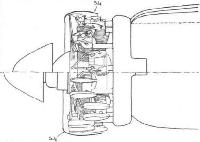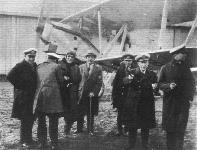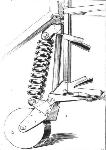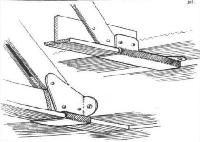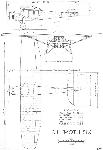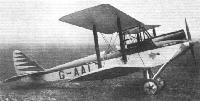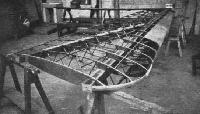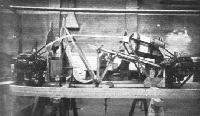Фотографии
-
Details of nose of "Siskin Jaguar" model, showing two types of ring, SJ4 and SJ6.
Самолёты на фотографии: Armstrong Whitworth Siskin - Великобритания - 1921
-
A FAIRCHILD IN CANADA: A side view of the Fairchild F.C.2 cabin monoplane equipped with an Armstrong Siddeley,"Lynx" geared engine. This machine, which carries a pilot and four passengers, can be fitted with floats, as shown, skis or wheels.
Самолёты на фотографии: Fairchild FC-1 / FC-2 - США - 1926
-
A SINGLE-WHEEL AMPHIBIAN: The Loening XO-10 is a two-seater experimental observation plane, fitted with Wright "Typhoon" engine. A three-lens camera is installed in the bottom, the opening being covered with a watertight cover when the machine is used on the sea. The inverted vee-type air-cooled engine is an interesting experiment.
Самолёты на фотографии: Loening OL / OA - США - 1923
-
Регистрационный номер: G-AACN [3] Самолёты на фотографии: Handley Page Gugnunc / H.P.39 - Великобритания - 1929
-
Регистрационный номер: G-AACN [3] This side view of the Handley Page Guggenheim Competition machine shows very clearly the lift slots open and the trailing edge flaps down, in the position of maximum lift.
Самолёты на фотографии: Handley Page Gugnunc / H.P.39 - Великобритания - 1929
-
Регистрационный номер: G-AACN [3] Further views of the Handley Page Type 39, with Armstrong-Siddeley engine.
Самолёты на фотографии: Handley Page Gugnunc / H.P.39 - Великобритания - 1929
-
H.P. Type 39 "Mongoose" Engine
Самолёты на фотографии: Handley Page Gugnunc / H.P.39 - Великобритания - 1929
-
SIR SEFTON BRANCKER IN GREECE: Air Vice-Marshal Sir Sefton Brancker recently visited Athens in connection with Civil Aviation developments and flew from Tatoi Aerodrome to Salonica in one of the Hawker "Horsleys" recently supplied to the Greek Naval Air Service. Our picture shows Sir Sefton (3rd from left) ready to leave, with Mr. A. C. Coutroubis (4th from left) and Capt. Voulgaris, Director-General of Ministry for Air (6th from left).
Самолёты на фотографии: Hawker Horsley / Dantorp - Великобритания - 1925
-
Регистрационный номер: J9766 The latest version of the Vickers Victoria is fitted with two Napier "Lion XI" engines and Handley Page automatic slots. The wheels under the tail skid are temporary, and not permanent fitments.
Самолёты на фотографии: Vickers Victoria - Великобритания - 1922
-
Самолёты на фотографии: De Havilland Hawk Moth / D.H.75 - Великобритания - 1928
-
Самолёты на фотографии: De Havilland Hawk Moth / D.H.75 - Великобритания - 1928
-
The tail wheel on the "Moth Six" is steerable, but a certain degree of play is allowed so as to avoid transmitting shocks to the rudder.
Самолёты на фотографии: De Havilland Hawk Moth / D.H.75 - Великобритания - 1928
-
The tail plane trimming gear on the "Moth Six." Inset, aileron construction in welded steel.
Самолёты на фотографии: De Havilland Hawk Moth / D.H.75 - Великобритания - 1928
-
The wooden ribs are attached to the wooden spars by small metal brackets.
Самолёты на фотографии: De Havilland Hawk Moth / D.H.75 - Великобритания - 1928
-
D.H. "Moth Six"
Самолёты на фотографии: De Havilland Hawk Moth / D.H.75 - Великобритания - 1928
-
A tri-motored metal Ford monoplane, the type employed by the Mexican Aviation Co. on the air services operated by them.
Самолёты на фотографии: Ford Tri-Motor / 4-AT / 5-AT - США - 1926
-
A NEW TROOP CARRIER: The Handley Page "Clive" is fitted with Bristol geared "Jupiter" engines, automatic slots and other things.
Самолёты на фотографии: Handley Page Hyderabad/H.P.24 / Hinaidi/H.P.33 / Clive/H.P.35 - Великобритания - 1923
-
AN AMERICAN TRAINING MACHINE: The Great Lakes Trainer is fitted with an American "Cirrus" engine, and is one of the first light 'planes to be fitted with the new Goodyear Air Wheels.
Самолёты на фотографии: Great Lakes 2-T-1 - США - 1929
-
Регистрационный номер: G-AADO [2] Самолёты на фотографии: Gloster AS.31 Survey - Великобритания - 1929
-
Регистрационный номер: G-AADO [2] OFF TO RHODESIA: Mr. A. S. Butler and Mrs. Butler left Heston Air Park on Thursday last in a "Gloster" Survey Machine with Bristol "Jupiter" engines. On the left Mr. Butler is seen handing a Russell Lobe parachute to his wife. On the right, the two travellers are settling themselves in the cockpit just before the start
Самолёты на фотографии: Gloster AS.31 Survey - Великобритания - 1929
-
THE AERIAL 'BUS: The Loening amphibian, which is employed on the "Air Ferry" services operated in America.
Самолёты на фотографии: Loening Air Yacht - США - 1928
-
THE B.F.W. MESSERSCHMITT M.23b: Fitted with Siemens SH 13 70 h.p. engine, this machine secured first place in the International Light 'Plane Tour of Europe last year
Самолёты на фотографии: Messerschmitt BFW M.23 / M.27 - Германия - 1928
-
THE B.F.W. MESSERSCHMITT M.23a: This version is fitted with a 40-h.p. Salmson AD 9 engine
Самолёты на фотографии: Messerschmitt BFW M.23 / M.27 - Германия - 1928
-
THE B.F.W. MESSERSCHMITT M.23b: Except for the fact that it is fitted with the "Cirrus" engine, this is similar to the machine flown to victory in the Tour of Europe by Morzik last year
Самолёты на фотографии: Messerschmitt BFW M.23 / M.27 - Германия - 1928
-
Регистрационный номер: PH-AGN THE PANDER-GIPSY: A Dutch private owner's machine, which, fitted with the D.H. Gipsy engine, has a top speed of 125 m.p.h. and a landing speed of 50 m.p.h. This machine is fitted with Bendix wheel brakes as standard.
Самолёты на фотографии: Pander P-1 / P-2 - Нидерланды - 1929
-
Регистрационный номер: G-AAJY THE LONG AND SHORT OF IT: Extreme ranges of floats constructed by Short Brothers - the large float for the three-engined monoplane (40ft. long, 22,600 lbs. displacement) and the wing-tip floats for the light amphibian (180 lbs. displacement each).
Самолёты на фотографии: Short Valetta / S.11 - Великобритания - 1930
-
THE MARGARETE: A glider of the intermediate type being flown by the flying section of the Technical High School at Darmstadt. They gained the first prize for the two-seater class in the Rhon Gliding Competition.
Самолёты на фотографии: Darmstadt D-04 - D-07 - Германия - 1922
-
Регистрационный номер: F-AJFV A RECORD BREAKER: An Albert (Genet). The altitude record gained was 7,730 m. (25,509 ft.) in the 3rd category, 350 kg. (771-6 lb.)
Самолёты на фотографии: Albert TE.1 / R.100 - Франция - 1926
-
Регистрационный номер: I-AANX THE BREDA-CIRRUS SEAPLANE: The Breda 15 is another of many machines fitted with the Cirrus engine. It is very fully equipped and agencies are now being appointed in this country.
Самолёты на фотографии: Breda Ba.15 - Италия - 1928
-
Регистрационный номер: G-AAVL THE BREDA-GIPSY LANDPLANE: A very low stalling speed of below 30 m.p.h. is claimed for this version of the Breda, together with a top speed of 105 m.p.h. when fitted with the Gipsy engine.
Самолёты на фотографии: Breda Ba.15 - Италия - 1928
-
Регистрационный номер: G-AALT Demonstrative: This "Gipsy-Moth," arranged as a single-seater, will be used by Capt. Broad for giving displays at meetings, etc. The machine can be identified by the red-top fuselage and the registration letters G-AALT.
Самолёты на фотографии: De Havilland Gipsy Moth / Moth X - Великобритания - 1928
-
"BACK TO NATURE" might be the title for this picture, which shows Marcus D. Manton at the controls of the London Gliding Club's machine near Guildford. Mr. Manton was one of the early Hendon pilots, and is now becoming interested in gliding.
Самолёты на фотографии: Lippisch / RRG Zogling - Германия - 1926
-
Регистрационный номер: VH-UKT AN AUSTRALIAN-BUILT COMMERCIAL AEROPLANE: The Larkin Aircraft Supply Co.'s "Lascoter" monoplane (220 h.p. Armstrong Siddeley "Puma"). This machine is claimed to be the first commercial aircraft completely designed and built in Australia to receive a certificate of airworthiness. It is mainly constructed of metal, and with the "Puma" engine and disposable load of 2,000 lbs. has a speed range of 45-112 m.p.h., and a ceiling of 15,000 ft. A "Nimbus" or "Jaguar" engine can also be fitted in this machine.
Самолёты на фотографии: Larkin (Lasco) Lascoter / Lascondor - Австралия - 1929
-
A view along the uncovered port wing of the HAC3 Meteor, 1929.
Самолёты на фотографии: Halton Meteor / H.A.C.3 - Великобритания - 1929
-
THE HALTON AERO CLUB'S "METEOR": This photograph snows the nacelle with the two Bristol "Cherub" engines.
A side view of the partially-completed Meteor fuselage. The front is to the right. Both Bristol Cherubs are in place, and the fuel tank can be seen behind the front one.Самолёты на фотографии: Halton Meteor / H.A.C.3 - Великобритания - 1929
-
The general layout is illustrated in the three-view general arrangement drawings.
Самолёты на фотографии: Halton Meteor / H.A.C.3 - Великобритания - 1929
-
THE EMSCO-CIRRUS: One of the many American machines now fitted with the American Cirrus engine. This machine has a top speed of 135 m.p.h. with a landing speed of 38 m.p.h.
Самолёты на фотографии: Emsco B-4 - США - 1930
Статьи
- Flight
